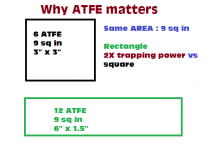When it comes to determining whether a spider trap will work in your environment the most basic comparison metric is trap dimensions.
Flat Trap Size:
The most basic of measurements:
Width X Length = Flat Trap Area
While this metric is the simplest, and can have applications for using traps in a virtual spider wall, Flat Trap Size does NOT consider the Active Trap Surface (glue area) reducing the utility of this metric for Virtual Wall Use.
Here are some examples of common Flat Trap Sizes:
| Brand / Model | Length | Width | Flat Area |
|---|---|---|---|
| Catchmaster 288i | 10″ | 2.5″ | 25″ |
| Traps Direct Advantage | 8.5″ | 2.75″ | 23″ |
Trap Footprint:
The trap footprint is the ground space required by the trap once it has been assembled. This metric can be a bit more complicated if the trap design allows for more than one placement orientation. The Primary Trap FootPrint will be considered to be the most obvious orientation of the trap. In many cases insect traps will have an exterior anchor strip which can be activated to keep the trap from moving. When an anchor strip exists, the orientation with the anchor strip will be considered the primary foot print.
When TAB or SLOT assembly areas over reach the trap dimensions those orientations of the spider trap will be excluded.
Here are some examples of Primary Trap Footprints
| Brand / Model | Length | Width | FootPrint Area |
|---|---|---|---|
| Catchmaster 288i | 3.5″ | 2.5″ | 8.75″ |
| Traps Direct Advantage | 3″ | 2.75″ | 8.25″ |
Trap foot prints are useful to ensure that enough space is available for placement in tight areas ( between appliances, under furniture behind toilets, under shelving.
